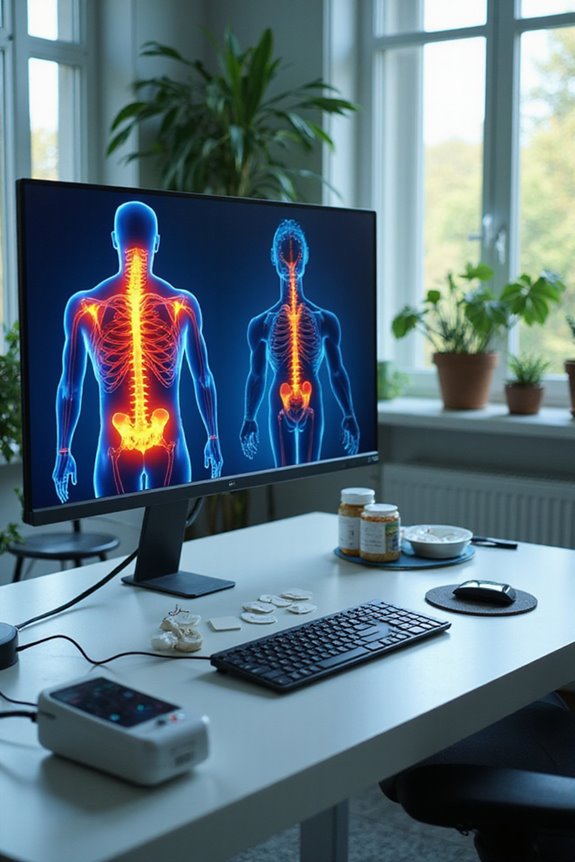Various technologies assist with workplace pain management, including:
- Wearable Devices: Track physiological data, monitor symptoms, and provide biofeedback for immediate relief.
- Mobile Applications: Facilitate pain tracking and enhance self-management.
- Electrotherapy Systems: Utilize TENS and NMES for effective pain relief.
- AI Software: Streamline documentation and generate personalized treatment plans.
- Telehealth Innovations: Enable virtual consultations and improve outcomes.
These advancements promote a healthier work environment while addressing chronic pain effectively. Further exploration reveals additional insights on this topic.
Key Takeaways
- Wearable devices track physiological data and provide biofeedback, helping monitor and manage workplace pain effectively.
- Mobile applications facilitate pain tracking and management, promoting user engagement and timely adjustments to treatment plans.
- Advanced electrotherapy technologies, like TENS and NMES devices, offer personalized pain relief and rehabilitation solutions for employees.
- AI-powered software systems streamline documentation and generate customized treatment plans based on individual patient data and history.
- Telehealth innovations enhance access to care, improving productivity and morale through effective chronic pain management strategies.
Wearable Devices for Pain Monitoring and Relief
Wearable devices have emerged as significant tools for pain monitoring and relief in workplace environments. These devices utilize wearable sensors to track physiological data, including heart rate and respiratory rate, which are pertinent to evaluating chronic pain conditions.
Key features include:
- Smart bands and patches that monitor symptoms associated with conditions like fibromyalgia and arthritis.
- Ergonomic monitors that detect postural and musculoskeletal strain, reducing the risk of workplace injuries.
- Devices providing biofeedback or electrical stimulation for immediate pain relief.
Mobile and Digital Pain Management Applications

Mobile and digital pain management applications represent a significant advancement in the domain of workplace health. These tools enhance self-management for employees with chronic pain, offering various mobile app features that include:
- Pain tracking
- Educational resources
- Behavior modification strategies
User engagement strategies are vital, promoting sustained interaction with the app. Evidence indicates these applications can improve pain control, thereby reducing absenteeism and presenteeism. They also foster a sense of community by providing support outside traditional clinical settings, addressing inequities in access to care. Additionally, continuous pain monitoring allows for timely adjustments to management plans, enhancing overall workplace productivity. As employers increasingly recognize workforce health as a priority, integrating these digital tools into occupational health frameworks is becoming essential for optimizing business performance.
Advanced Electrotherapy Technologies

Advancements in electrotherapy technologies have transformed workplace pain management strategies, offering a variety of non-invasive treatment options that enhance employee well-being.
- TENS Devices: Deliver low-frequency impulses to block pain signals, widely used for back pain and muscle spasms. FDA-approved, often reimbursable by insurance.
- NMES: Stimulates muscle contractions to rehabilitate and strengthen muscles, beneficial for workplace injuries.
- Galvanic Stimulation: Uses direct current to improve blood flow and reduce swelling, effective for acute injuries.
- IFC Machines: Provide deeper pain relief through high-frequency impulses, suitable for chronic conditions.
- Integrated Systems: Combine multiple electrotherapy modes for personalized treatment regimens, enhancing effectiveness.
These electrotherapy advancements represent significant pain relief technologies, supporting a healthier workplace environment.
AI-Powered Pain Management Software Systems

AI-powered pain management software systems are revolutionizing how healthcare providers approach pain treatment by streamlining workflows and enhancing patient care.
- AI automation reduces operating costs and enhances documentation accuracy through customizable templates for procedures such as injections and physical therapy.
- Ambient Virtual Scribe and SMART Orders™ features can save providers up to three hours daily on documentation.
- Integration with electronic health records (EHR) allows for efficient cross-referencing of patient data, facilitating more precise diagnoses.
- AI tools generate personalized treatment plans by analyzing medical history and lifestyle factors, improving therapeutic effectiveness.
- Real-time decision support from AI guarantees adherence to best evidence-based practices, reducing prolonged pain and recovery times.
These advancements foster a collaborative environment, enhancing the overall quality of pain management.
Ergonomics and Virtual Injury Prevention Technologies

In an era where workplace safety is paramount, ergonomics and virtual injury prevention technologies are playing an essential role in minimizing musculoskeletal disorders (MSDs) and enhancing employee well-being.
- Ergonomic Assessments: Regular assessments identify risk factors, leading to tailored workplace modifications that support employee health.
- Wearable Sensors: These devices monitor movements, providing real-time feedback on potential ergonomic risks.
- Virtual and Augmented Reality: Training simulations educate workers about safe practices and injury prevention.
- Data Analytics: Aggregated data informs proactive modifications to work environments, reducing injury risks.
- Computer Vision Systems: Continuous posture analysis detects improper ergonomics, prompting immediate corrective action.
Telehealth and Remote Pain Management Innovations
As the demand for accessible healthcare solutions increases, telehealth has emerged as a pivotal innovation in remote pain management.
- The global telehealth market is projected to exceed USD 175.5 billion by 2026, illustrating significant growth in this sector.
- Adoption of telehealth has surged since 2020, largely due to the pandemic and increased acceptance of virtual consultations for both chronic and acute pain management.
- Telehealth accessibility enhances care for individuals with mobility issues or those residing in remote areas, minimizing the need for travel.
- Integration of telehealth into standard care pathways has improved patient outcomes and workflow efficiency.
- Public awareness of telehealth options has made virtual consultations a preferred complement to traditional pain management clinics, fostering a sense of community in care.
Biofeedback Wearables for Stress-Related Pain
The integration of biofeedback wearables for stress-related pain management represents a significant advancement in healthcare technology. These devices utilize wearable sensors to monitor physiological signals such as heart rate variability (HRV), respiration, and skin conductance, providing real-time insights into stress and pain levels.
Key features include:
- Neurofeedback headbands (e.g., Muse) for brainwave tracking.
- Rings (e.g., Oura) that assess HRV.
- Mobile applications offering visual or audio feedback.
Biofeedback techniques empower users to regulate autonomic functions, promoting relaxation and reducing pain perception. Longitudinal data storage enables personalized adjustments over time. Clinical evidence supports the effectiveness of these wearables in managing pain linked to stress and anxiety, highlighting their growing relevance in workplace pain management strategies.
Posture Correctors to Prevent Musculoskeletal Issues
Posture correctors play an essential role in workplace ergonomics, particularly in preventing musculoskeletal issues associated with prolonged sitting and poor postural habits. These devices serve as reminders to enhance posture, promoting shoulder retraction and improving neck alignment.
Key points include:
- Enhanced posture can lead to increased neck range of motion and stability.
- Effective for minor posture issues; severe conditions require professional consultation.
- The global posture corrector market was valued at approximately USD 1.10 billion in 2022, with growth projections exceeding USD 2.35 billion by 2032.
- While posture correctors encourage posture awareness, they should complement ergonomic furniture and adjustments for ideal results.
Incorporating these tools can support a healthier work environment, aligning with the broader goal of reducing musculoskeletal complaints.
Integration of Physical Therapy and Guided Exercises
Integrating physical therapy and guided exercises within the workplace has become increasingly essential for addressing musculoskeletal (MSK) disorders effectively. This physical therapy integration offers immediate access to care, leading to reduced recovery times and targeted interventions for specific MSK issues.
Key benefits include:
- Increased employee adherence due to convenient participation
- Direct collaboration between physical therapists and employers, enhancing workplace safety
- A proactive approach that minimizes chronic pain risks
Moreover, guided exercise programs can greatly reduce absenteeism and presenteeism, directly impacting productivity and morale. The use of technology, such as digital exercise platforms and wearable devices, supports the implementation of these programs, ensuring employees receive personalized, effective care. The integration of physical therapy and guided exercises ultimately fosters a healthier workplace environment.
Role of Digital Communication in Pain Management Coordination
Digital communication plays an essential role in coordinating pain management strategies within the workplace, especially as organizations seek to enhance employee health and productivity.
- Digital collaboration tools, such as SWEPPE, allow employees to effectively track pain goals and share updates with employers, fostering improved pain communication.
- Employers gain valuable insights, leading to tailored support and enhanced productivity.
- Real-time data access streamlines workplace accommodations and planning.
- The Pain-at-Work (PAW) Toolkit exemplifies effective digital intervention for chronic pain self-management, emphasizing evidence-based approaches.
- Improved communication mitigates workplace failures linked to unaddressed pain, as 86% of failures stem from poor communication.
- Continuous feedback channels enable dynamic adjustments, benefiting both employees and organizational health.
Digital communication is vital for creating a supportive work environment.
Frequently Asked Questions
How Do I Choose the Right Wearable Device for My Pain?
Choosing the right wearable device for pain management involves evaluating wearable features, ensuring device compatibility with specific pain types, and considering comfort, usability, and support to enhance overall well-being in a shared environment.
Are There Any Side Effects of Using Electrotherapy for Pain Relief?
Electrotherapy benefits include effective pain relief; however, users should be aware of potential electrotherapy risks such as skin irritation, burning sensations, and rare side effects like headaches or muscle spasms, emphasizing the importance of proper usage.
Can I Use Multiple Pain Management Technologies Simultaneously?
The potential for using multiple pain management technologies simultaneously exists, provided device compatibility is assessed. Combination therapies can enhance relief, yet careful monitoring is essential to guarantee safety and optimize patient outcomes effectively.
How Secure Is My Personal Health Data With Telehealth Platforms?
In 2023, nearly 80% of healthcare data breaches stemmed from hacking, emphasizing the importance of data encryption and adherence to privacy regulations. Telehealth platforms must enhance security measures to better protect personal health information.
What Costs Are Associated With Workplace Pain Management Technologies?
Cost analysis of workplace pain management technologies reveals significant financial implications. Technology investments, while initially high, can lead to long-term savings by enhancing productivity and reducing healthcare costs, fostering a healthier work environment for all employees.




